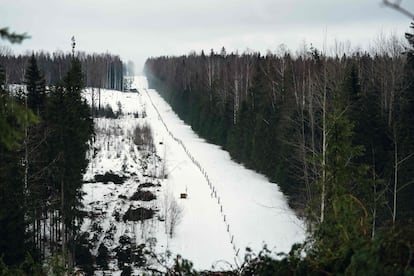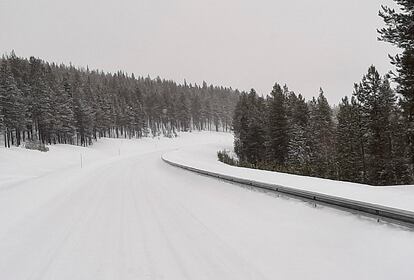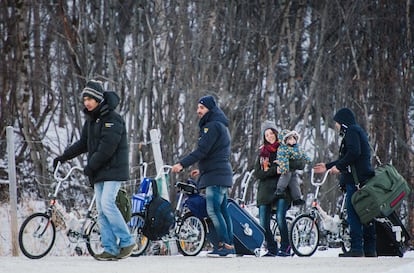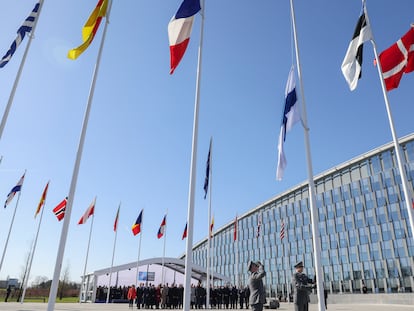Europe’s new wall: Finland is building a 124-mile-long border fence to protect itself from Russia
The barrier, which will cover 15% of the border between the two countries, symbolizes the distrust NATO’s most recent member state feels towards Moscow


A 30-mile-long stretch along a remote road in northeastern Finland reflects — almost like no other symbol — the deterioration of relations between Russia and the Nordic country. It also vividly illustrates the transformation of the European security framework over the past year, which was shaken following the Russian invasion of Ukraine.
The track that leads through the infinite forest to the Raja-Jooseppi border crossing is covered in snow. In light of the tension with Moscow, nearly all the vehicles that circulate in this area belong to the security forces. The road has been abandoned by the snowplows, while the border facilities — which once received several million euros in subsidies to favor transit with Russia — only receive about 10 people each day.
The cranes will return soon, but this time they won’t be erecting buildings. Instead, they will be building a security fence along what constitutes a new border between NATO and Russia, after Finland joined the Atlantic Alliance last week.
The Raja-Jooseppi border crossing is located in the least populated area — and one of the coldest — in the entire European Union. Located in the heart of a national park, immense pine and fir forests stretch out around it. Thousands of square miles in which no one resides, where bears and wolves roam freely and snow lasts from October to May.
Opened in 1967, its annual records reflect constant increase in traffic until 2014, when Russia annexed the Ukrainian peninsula of Crimea. Traffic decreased even further during the pandemic, before finally hitting an all-time low when Ukraine was invaded in February 2022.

The absence of vehicles and the accumulated snow give the brand new border facilities a feeling of semi-abandonment. Three months before the invasion of Ukraine, the four lanes with covered roofs were inaugurated, with the intention of making inspections faster and more comfortable in temperatures that can plummet to 50ºF below zero. Yet, more than a year later, they have never been used simultaneously. There aren’t even enough staff to examine more than one vehicle at a time.
Mikael and Tapio — two young border guards who prefer not to disclose their last names — wait in the booth for the clock to strike 3:00 p.m. It has been a “very quiet” day and it does not seem likely that anyone will show up in the 35 minutes remaining before the border post closes up until 9 a.m. the following day.
“It’s more comfortable here than out there in the cold,” says Mikael, who provokes a shy laugh from his partner, a few years his junior.
The 60 members of the border guard team stationed in Raja-Jooseppi — whose base is about four miles from Russian territory — patrol the entire area closest to the border with snowmobiles. The strip of land is off-limits to the public, unless one requests a special permit.
In 2013, some 400 people crossed this post daily. Today, the average doesn’t even reach 10. On some days, no one passes through at all.
“Some are Russian, on the way out… and Finns, on the way back,” Mikael grunts, referring to citizens with dual nationality, which has been allowed since 2003. There are about 30,000 dual citizens in Finland, who can still travel from one country to the other with hardly any restrictions.
With the consensus of all the parliamentary groups — and at the proposal of the Finnish Border Guard — the construction of the fence on the eastern border was approved last October. Sanna Marin, the prime minister, who just resigned after losing the 2023 elections, argued that it was necessary in view of “the new security situation” generated by the war in Ukraine.
The Social Democrat stressed that the main purpose of the wall would be prevention against “hybrid threats” from Russia, especially “the exploitation of mass migration.” A few months ago, Finland made a historic turn by abandoning its neutrality and beginning the process of joining the Atlantic Alliance — a process that ended successfully a week ago.
In February, the construction of two miles of fence began in the south, near the city of Imatra. The pilot project is scheduled to end in June, but the final work — which will cover 15% of the 832 mile-long border between Finland and its gigantic neighbor — will not be completed until 2026.
Most of the obstacles will be erected in the southernmost strip, but fences will be built around the eight border posts (the length between each section is confidential information), including those at Salla and Raja-Jooseppi, north of the Arctic Circle.
“[In 2015 and 2016], Russia used migrants as a weapon in that area of Lapland,” says Pekka Virkki, an analyst with the military magazine Suomen Sotilas, who spoke to EL PAÍS by phone. “The risk that Moscow will resort to mass migration again has always been latent,” the expert adds. He considers the fence to be “a symbol” of the new relationship with the Eurasian country.
At the end of 2015, when hundreds of thousands of migrants crowded the southwestern borders of the E.U., a few hundred sought refuge at the Storskog border post — the only one between Russia and Norway — inaugurating the so-called Arctic route.
Eventually, Oslo modified legislation to make access to asylum in the north of the country more difficult but only after accumulating 5,600 applications. The images of exhausted migrants, riding cheap bikes on snowy roads (Russia prohibits crossings on foot) began to be seen in Salla and Raja-Jooseppi. More than 1,600 refugees entered Finland that winter through the two northernmost crossings.

The arrival of Syrians, Afghans and Iraqis in Finnish Lapland was cut short in March of 2016, after an agreement was signed in Moscow between Finnish President Sauli Niinistö and Vladimir Putin, whereby the Raja-Jooseppi and Salla crossings could only be used for the following six months by Russian and Finnish citizens.
Niinistö was in office for a decade. He was one of the European leaders who had warm relations with the Russian president. But shortly after his visit, Putin declared that, when he looked at the border, he saw “Finns” on the other side… but that if Finland ever entered NATO, he would see “enemies.”
The future wall — which will add up to a total of 124 miles — will cost approximately $400 million. It will be a robust 10-foot-high fence, topped with barbed wire and equipped with night vision cameras, loudspeakers, spotlights and a parallel road. The work is in line with the walls that Poland and the Baltic countries have built (or are currently building) on their borders with Russia and Belarus. Since 2020, the Belarusian regime has encouraged and facilitated the arrival of tens of thousands of migrants at the E.U.’s external borders, in response to various sanctions imposed by Brussels.
The Finnish border authorities maintain that the wall is “necessary” to prevent “the instrumentalization of massive arrivals” and that no alternative is “more economical or more effective.” In July, reforms to the Border Guard Law were approved, which allow the government — in a crisis situation — to centralize the reception of asylum applications at a single border post. Official documents mention that the wall will reinforce “regional security and prevent possible territorial annexations.” However, Virkki and other analysts consulted consider that its usefulness at the military level will be “practically nil.”
Finland took longer than Poland and the Baltic countries to approve the construction of its border fence. It will take almost four years of work to limit the impact of the infrastructure project on water channels and animal crossings. Meanwhile, the instability of the terrain and the harsh, dark and long Finnish winters — in addition to the compulsory purchase procedures and the open competition for the awarding of the building contracts — will also delay its construction.
The wall will reflect the definitive cooling of ties that have been fostered and strengthened since the mid-1990s. “Relationships are frozen, but luckily, they aren’t dead; we can still maintain personal contact with our relatives, colleagues and friends in Russia,” says Olga Davydova-Minguet, a professor at the University of Eastern Finland.
The researcher — who has dedicated more than 20 years to studying the cross-border relationship between the two countries — notes that the consequences of the restrictions derived from the war have affected many different economic sectors, as well as the academic field and the personal ties between tens of thousands of citizens.
Davydova-Minguet — who emigrated to Finland in 1991 from the Russian city of Petrozavodsk, about 120 miles from the border — highlights the impact that restrictions on cross-border crossings have had on the almost 90,000 Russophones residing in Finland, most of them with relatives in Russia. The changes are more evident in the south, in cities such as Lappeenranta or Joensuu, where a significant portion of the population speaks Russian as their mother tongue, or in small towns very close to the border, where most businesses have shuttered due to the absence of tourists.
Jussi P. Laine, a professor of Human Geography and Davydova’s colleague at the University of Eastern Finland, flatly rejects the construction of the border fence. “Multiple studies show that the costs of building walls are greater than their benefits,” says the researcher, who specializes in mobility and cross-border security.
“The fence creates a false sense of security, distracting people from the real reasons for insecurity,” Laine points out, adding that, should Finland face episodes of mass migration, the obstacles will only cause migrants to reorganize into smaller groups that are less visible and more difficult to monitor.
“In most cases, the walls haven’t reduced the number of irregular crossings, they have only made them more dangerous and lethal,” he adds.
With Finland’s entry into NATO, the Alliance has incorporated a country with the greatest military capability of all new members over the last two decades and has more than doubled its border with Russia. A dividing line that stretches from the Arctic to Kaliningrad — the ends of which are very close to the Russian bases of the Northern Fleet and the Baltic Fleet. More than 1,200 miles of border, in which walls — reminiscent of the Iron Curtain — proliferate, indicating that there is little hope of normalizing relations with Russia in the short or medium-term. It is a border that has been transformed in recent decades and that is closed to Russian tourists, except through the Storskog border crossing, the only one that, since 1949, has separated NATO from its main reason for existing.
Sign up for our weekly newsletter to get more English-language news coverage from EL PAÍS USA Edition
Tu suscripción se está usando en otro dispositivo
¿Quieres añadir otro usuario a tu suscripción?
Si continúas leyendo en este dispositivo, no se podrá leer en el otro.
FlechaTu suscripción se está usando en otro dispositivo y solo puedes acceder a EL PAÍS desde un dispositivo a la vez.
Si quieres compartir tu cuenta, cambia tu suscripción a la modalidad Premium, así podrás añadir otro usuario. Cada uno accederá con su propia cuenta de email, lo que os permitirá personalizar vuestra experiencia en EL PAÍS.
¿Tienes una suscripción de empresa? Accede aquí para contratar más cuentas.
En el caso de no saber quién está usando tu cuenta, te recomendamos cambiar tu contraseña aquí.
Si decides continuar compartiendo tu cuenta, este mensaje se mostrará en tu dispositivo y en el de la otra persona que está usando tu cuenta de forma indefinida, afectando a tu experiencia de lectura. Puedes consultar aquí los términos y condiciones de la suscripción digital.
More information
Archived In
Últimas noticias
Welcome to the post-religion era: The idea of Christianity as the absolute truth has become obsolete
‘I thought you would like it’: The risky sexual practice popularized by TV shows and TikTok
The digitalization of tourism: ‘They promise experiences and gave us the worst possible one’
Mexican peso defies uncertainty with forecasts of a new period of stability in 2026
Most viewed
- Sinaloa Cartel war is taking its toll on Los Chapitos
- Reinhard Genzel, Nobel laureate in physics: ‘One-minute videos will never give you the truth’
- Oona Chaplin: ‘I told James Cameron that I was living in a treehouse and starting a permaculture project with a friend’
- Why the price of coffee has skyrocketed: from Brazilian plantations to specialty coffee houses
- Silver prices are going crazy: This is what’s fueling the rally










































